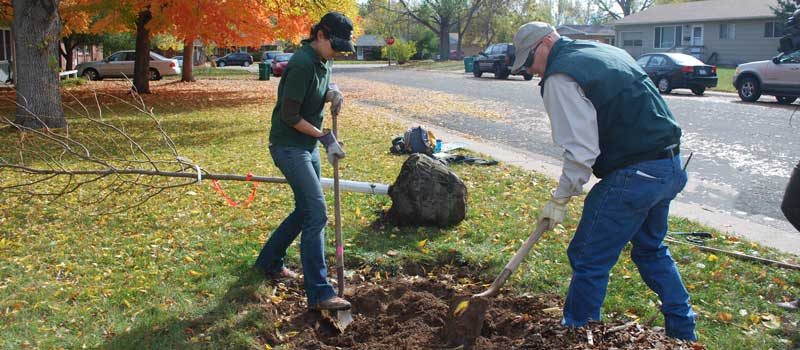 Spring is a great time to plant a new tree in your landscape. And, how easy it is to plant a tree, right? Dig a hole, plop it in, and cover it up. Unfortunately, if you want a tree that will thrive for many years, there’s much more to it than that. Luckily with a little forethought and effort your new tree will have a long happy life in your yard.
Spring is a great time to plant a new tree in your landscape. And, how easy it is to plant a tree, right? Dig a hole, plop it in, and cover it up. Unfortunately, if you want a tree that will thrive for many years, there’s much more to it than that. Luckily with a little forethought and effort your new tree will have a long happy life in your yard.
The main issue with newly planted trees is that they have a reduced root system, which leads to transplant shock. The goal is to promote rapid root growth so the tree can take up the water and nutrients it needs to grow.
By far the leading cause of tree deaths in landscapes is trunk girdling roots, or roots that grow around the trunk and cut off water and nutrient flow to the rest of the tree. These roots may be visible above ground, but often times are below where we can’t see them. The decline caused by these roots can take many years to begin, leaving us wondering what went wrong. The main factor contributing to these trunk girdling roots is planting trees too deeply. Follow the steps below to plant your tree perfectly.
First, determine the depth of your hole. The top of the root ball of the tree should be one to two inches above the soil level, and the root ball should not be covered with backfill soil. This will allow water to more easily reach the roots and allow them to grow. Don’t forget to check how far down the roots are in the root ball, if they are more than 3 inches deep, raise the tree up a little more above grade.
The next step is to dig a saucer shaped hole that has a width three times the diameter of the root ball. Now, set the tree in place, and remove all containers and wrapping. Finally, you will add the backfill soil. Don’t pack the soil down too hard, that will impede the movement of water and air to the roots. If you are in a windy or high traffic area, you may need to stake your tree. Be sure to use a flat piece of fabric that won’t dig into the tree’s trunk, and stake before you water the tree for the first time.
Next water the area to settle the soil. You may need to add a little more soil once it settles, but remember not to cover the top of the root ball with backfill soil. The final step is to mulch. Don’t place the mulch on top of the root ball, just on top of the backfill soil. You want to mulch about 3-4 inches deep to prevent weeds and soil compaction. The mulch should not be touching the tree’s trunk. You can find this information in more detail at https://static.colostate.edu/client-files/csfs/pdfs/TreePlanting_636.pdf.


